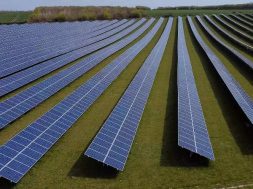
Import duties on solar equipment will delay Modi govt’s renewable goals
A 25 per cent duty on solar equipment imported from China and Malaysia has been imposed.
New Delhi: India has imposed duties on imports of solar equipment from China and Malaysia lasting two years. The aim is to kick-start a domestic industry that’s failed to take off in the face of ever-cheaper imports of solar cells and modules. China accounted for 89 percent of imports in the last financial year. The protectionist move risks setting back India’s climate change commitments by slowing the buildup of renewable energy capacity, even as prices for solar power in the world’s second-most populous nation fall to record lows.
1. How much of India’s energy is from renewable sources?
Renewable energy comprises about a fifth of India’s total installed power capacity. Even so, solar capacity remains less than a quarter of the ambitious 100 gigawatts Prime Minister Narendra Modi has targeted by 2022. He’s also aiming for 60 gigawatts from wind power. For the 2015 Paris agreement on climate change, India set a goal of having 40 percent of its installed electric capacity powered by non-fossil-fuel sources by 2030.
2. What exactly are the tariffs?
India imposed a 25 percent so-called safeguard duty on solar cells and modules imported from China and Malaysia effective July 30. The duty will fall to 20 percent after a year and 15 percent after 18 months. Domestic solar power equipment companies had complained that they were being undercut. After weeks of delays, including court challenges, the tariff was implemented in September.
3. Can the domestic industry step up?
There’s something of a shortfall. India can produce enough solar cells to meet just 15 percent of its annual installation target of 20 gigawatts of solar capacity, according to government estimates. Imports from China helped bridge the gap, hence the concern that the tariffs will in fact hamper the renewable push. Past attempts to bolster domestic manufacturing have been downsized and delayed, as potential bidders worry about the sustainability of projects.
4. How does India justify the tariff?
India overtook Japan as China’s biggest solar panel export market last year, buying about 31 percent of Chinese shipments. Overseas supplies have caused or threatened “serious injury” to local manufacturers, India’s Directorate General of Trade Remedies wrote in its recommendation to impose the duty. It noted local producers’ market share had fallen to 7 percent in 2017-2018 from 10 percent three years earlier.
5. Are solar tariffs just an India thing?
Hardly. U.S. President Donald Trump in January approved duties of as much as 30 percent on solar equipment made outside the U.S. The European Union recently ended anti-dumping measures on China’s photovoltaic products, after introducing anti-subsidy and anti-dumping duties in 2013. The solar industry has been transformed by subsidies in China that have helped it install more photovoltaic capacity than any other country. The nation added a record 53 gigawatt of solar capacity last year alone.
6. What does China say?
The tariff will damage both Indian buyers, who pay most of the duties, and Chinese producers, for whom demand may weaken, the China Chamber of Commerce for Import and Export of Machinery and Electronic Products said before the tariff was implemented.
7. What will happen to India’s renewable goals?
Solar installations are likely to slow, at least temporarily, in 2018 as power project developers adjust to the tariffs, according to Goldman Sachs Group Inc. The decision will also have ramifications for project schedules, potentially stretching them. For instance, the western state of Gujarat, Modi’s home state, has offered a longer timeline of two years to complete projects in its latest auctions, allowing developers to factor in an eventual return to zero tariffs on Chinese imports. According to Bloomberg NEF, the duty could increase the capital cost of solar plants by as much as 14 percent. Even without the tariffs, India was likely to fall short of its 2022 targets, BMI Research said in a report.
The Reference Shelf
The commerce ministry’s recommendation on tariffs. Why China’s restrictions on solar are a really big deal, says BNEF. India safeguard duty to impact 14.6GW of solar projects, says BNEF. India is China’s largest solar equipment buyer. A QuickTake on Trump taxing solar panels. Goldman Sachs says India solar build to slow. India to miss renewables capacity target set for 2022, BMI says. – Bloomberg














